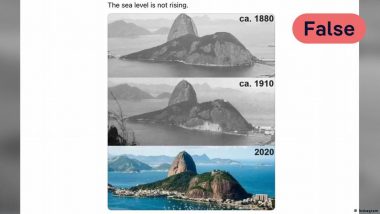A viral photo collage from Rio de Janeiro's Sugarloaf Mountain purportedly shows that sea levels have remained stable for 140 years. Why does the mountain seem to have gained instead of lost land mass?Rio de Janeiro's Sugarloaf Mountain is not only one of Brazil's most symbolic landmarks but also recently became the subject of a viral claim on rising global sea levels.
Also Read | India News | Businessman Murder: MSME Director and Four Others Remanded in Police Custody Till June 15.
A collage of the geological site has been shared widely in at least eight different languages and on several social media platforms.
Also Read | India News | Andhra CM Chandrababu Naidu, Family to Have Darshan of Lord Venkateswara at Tirumala.
The collage is made up of three images, each labeled with a date. The first one is from the 1880s, the second from the 1910s and the third has a 2020 time stamp. The three pictures seem to show similar or even sinking water levels, which has led to the following claim:
Claim: Three juxtaposed images of Rio de Janeiro’s Sugarloaf Mountain, taken in different centuries, allegedly show sea levels have not risen since the end of the 19th century.
The collage was shared on X, Facebook and Instagram, among other platforms, and has circulated in at least the following languages: English, German, Chinese, Turkish, Polish, Dutch, French, and Slovak.
Users often shared the collage with ironic comments, such as "sea levels are rising and rising and rising."
A common argument among climate change skeptics is that sea level rise is exaggerated.
DW fact check: False
How sea levels differ in various regions
DW Fact check was not able to verify with certainty whether the dates on the pictures were accurate. But even if they were, experts have warned that juxtaposing images of one location, especially at such a wide angle, is not an effective way of proving whether sea levels have risen in general.
One reason is that rising levels are not affecting every part of the world in the same way. Sea level rise has been described as an uneven phenomenon caused by the Earth's gravitational field and by ocean dynamics and weather patterns like El Nino and La Nina.
This means that some parts of the world won't see much of water level rise along their coastlines, but others will be submerged, as this video by DW Environmentexplains.
So even if water levels around Rio de Janeiro had remained stable in the last 140 years, as users misleadingly suggested, the three images of Sugarloaf Mountain cannot be extrapolated to speak of a wider phenomenon.
Land reclamation on the Urca peninsula
In fact, Eduardo Siegle, professor in coastal dynamics at the University of Sao Paulo, told DW that "along the Brazilian coast, we observe sea level rise patterns similar to the global pattern, with an increase of around 20 centimeters during the last century."
The US National Oceanic and Atmospheric Administration (NOAA) said global mean sea level has risen about 8-9 inches (21-24 centimeters) since 1880. The European Union's European Environment Agency (EEA) explained the level has increased about 21 centimeters since 1900 at an accelerating rate.
This global rise is seen as a result of human-caused global warming, "with recent rates being unprecedented over the past 2,500-plus years," according to NASA, the US space agency. The NOAA says the area around Sugarloaf Mountain has also seen a rise in water levels.
But why do we then see an area covered by buildings at the foot of Sugarloaf Mountain and Urca Hill in the more recent images that were not there before? There is a simple explanation that most users who shared the Social Media post were probably not aware of.
"This is an effect of a land reclamation," Siegle explained. "It's an artificial process where, at the beginning of the 20th century, they built a sea wall and filled it with sand and rocks, so afterward they could build the Urca neighborhood on top of it. So this expansion in coastal areas that we see on this protected side of the Sugarloaf and Urca hill has nothing to do with the sea level going up or down."
What about tidal conditions?
Siegle also told DW that "effects on the coastline need to be assessed locally, taking into account local processes, such as sediment budget, topography, waves, tides, etc."
Seasonal patterns and tidal fluctuations can influence water levels, which means that more data beyond the year would be needed to make a substantial comparison between images of one location.
Experts have made similar arguments in the past as other well-known landmarks have been the subject of similar disinformation.
Last year, two pictures of the Statue of Liberty in New York City were juxtaposed to allegedly show water levels had not risen between 1898 and 2017.
In 2022, two photos of Fort Denison in Sydney Harbor, taken in different centuries, also circulated with a similar claim that sea levels have risen "approximately 0.0 centimeters over the past 140 years."
Sea level rise as a 'severe adaptation challenge'
Ultimately, the photo collages of these global landmarks are not proof that sea levels have not risen in the past few years. Instead, institutions like the Intergovernmental Panel on Climate Change (IPCC) have warned that rising sea levels will continue to impact communities worldwide.
The IPCC said sea level rise poses a "severe adaptation challenge" with risks that are projected to increase in the upcoming decades.
"Reducing the acceleration of sea level rise beyond 2050 will only be achieved with fast and profound mitigation of climate change."
Edited by: Davis VanOpdorp
(The above story first appeared on LatestLY on Jun 12, 2024 07:10 PM IST. For more news and updates on politics, world, sports, entertainment and lifestyle, log on to our website latestly.com).











 Quickly
Quickly












 GT
GT







